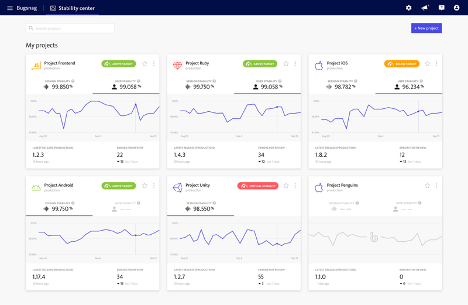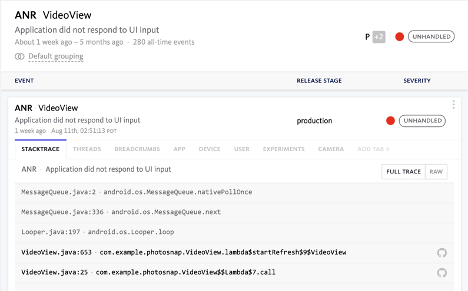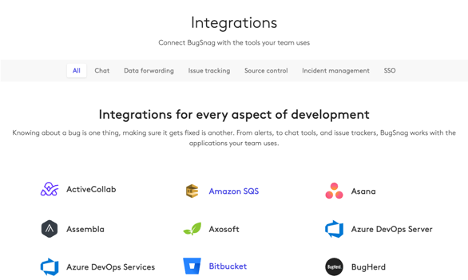How to Achieve Better Visibility with BugSnag Error Monitoring
Observability and visibility are essential concepts for software businesses. As applications become more complex, these error monitoring tools have become crucial to understand how applications behave, identifying problems, and troubleshooting them quickly.
Let’s look at the difference between observability and visibility, how error monitoring supports both goals, and why you may want to consider BugSnag for real-time insights.
Observability and visibility are related concepts, but not every error monitoring solution supports both goals.
Observability vs. Visibility: What’s the Difference?
Observability and visibility are related concepts with slightly different meanings in software development.
Imagine a patient walks into a doctor’s office for an annual checkup. The doctor will typically look for any symptoms – like aches or pains – to assess the patient’s internal health. With those symptoms, they can usually narrow down the possibilities of potential underlying health issues.
Observability takes a similar approach by analyzing external outputs to assess how an application functions internally. In particular, test engineers look at metrics, logs, and traces – the three pillars of observability – to understand how the application behaves.
On the other hand, visibility is more like a medical chart. It provides a high-level overview of a patient’s health status. Application visibility refers to the ability to see the status of an application from high above, including metrics like availability or performance.
Observability and visibility are essential to a well-functioning software business. If you know an application’s healthy at a high level, it’s much easier to deploy updates or changes. But even a minor change is nerve-wracking if you don’t have visibility into an application’s health.
How Error Monitoring Supports Both Goals
Error monitoring is essential to application observability and visibility, helping surface and diagnose issues.
Error monitoring is the process of tracking and reporting errors at various levels of an application or system. For example, error monitoring solutions often collect data on errors in an application, including error messages and stack traces, to help developers troubleshoot the problem.
At the same time, error monitoring solutions typically provide tools to analyze and visualize error data. These insights can help developers and managers track error rates and performance metrics over time, providing deeper insights into the application’s health.
In addition to tracking application-related issues, error monitoring tools can help identify and troubleshoot infrastructure problems. These capabilities are especially critical for microservices that rely on the availability of multiple components powering an application.
It’s important to note that not every error monitoring tool supports both observability and visibility. Some solutions only provide stack traces and other diagnostics rather than high-level insights that you can use to understand the application’s behavior at a high level.
How BugSnag Improves Observability and Visibility
BugSnag enables software teams to monitor their application stability in real-time and get the necessary visibility to make decisions.

BugSnag’s Stability Score provides a definitive metric for deciding whether to spend time building features or fixing errors. Rather than trying to develop and track custom KPIs, these scores provide a single objective metric to align the team and simplify decisions.
Meanwhile, the Releases Dashboard makes it easy to compare the health of releases using the Stability Score and other information about errors. If you use feature flags for more granular deployments, you can see the errors associated with them in real-time.

When it’s time to fix bugs, BugSnag provides full-stack observability and rich diagnostics to make every error actionable. The platform automatically groups errors by root cause, provides fully-readable stack traces, and offers breadcrumbs to help reproduce the issue.
You can also configure customizable alerts to prevent notification fatigue and drive code ownership. For instance, you might create segments for the checkout functionality of an e-commerce app or high-value customers and then route errors to the right people quickly.
Achieving Real-Time Visibility & Observability
Error monitoring tools provide the data teams need to achieve observability and visibility, but not necessarily the processes.
The first step in attaining observability is defining key metrics to assess application health. For instance, at BugSnag, we look at the percentage of error-free sessions to total sessions. The acceptable rate may depend on your service level agreements or other factors.
After defining metrics, teams should set up and integrate error monitoring into their development workflows. You’ll need to install error monitoring solutions and combine them with development tools, issue trackers, management dashboards, and other tools.

Next, you should segment errors based on the individual or team responsible for them. With BugSnag, you can create bookmarks to segment errors and configure notifications for specific individuals or groups. That way, you can ensure they get fixed quickly.
Finally, management teams should periodically review error monitoring and performance data to ensure teams are resolving issues efficiently and overall application health remains strong. For instance, BugSnag provides an API to share scores anywhere.
The Bottom Line
Observability and visibility are essential to creating an exceptional user experience. Unfortunately, many error monitoring solutions only address half of the problem – diagnosing errors. The best solutions add the ability to monitor trends over time and assess an application’s health in real time by looking at its current state.
BugSnag provides real-time observability through Stability Scores, enabling managers to make data-driven decisions. Meanwhile, its diagnostic tools provide visibility into an application, helping engineers quickly remediate any bugs before they affect several users. And with integrations with the most popular tools, it’s an easy addition to your existing workflow.